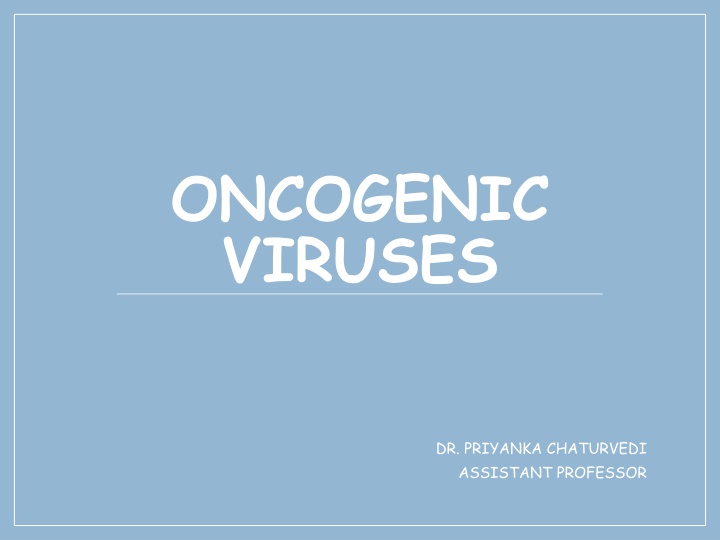
Viral Oncogenesis and Host Cell Regulation
Learn about the role of oncogenic viruses in cancer development, the complex process of viral oncogenesis, and the genes involved in regulating host cell growth. Explore how oncogenes, proto-oncogenes, and tumor suppressor genes play key roles in cellular transformation and cancer progression. Discover the essential events that must occur before oncogenesis takes place.
Download Presentation

Please find below an Image/Link to download the presentation.
The content on the website is provided AS IS for your information and personal use only. It may not be sold, licensed, or shared on other websites without obtaining consent from the author. If you encounter any issues during the download, it is possible that the publisher has removed the file from their server.
You are allowed to download the files provided on this website for personal or commercial use, subject to the condition that they are used lawfully. All files are the property of their respective owners.
The content on the website is provided AS IS for your information and personal use only. It may not be sold, licensed, or shared on other websites without obtaining consent from the author.
E N D
Presentation Transcript
ONCOGENIC VIRUSES DR. PRIYANKA CHATURVEDI ASSISTANT PROFESSOR
OVERVIEW Among the organisms with oncogenic potential, viruses account for the majority. Viruses malignancies. account for 15% of all human Two infections: vaccine preventable oncogenic viral 1. Human papillomavirus causing carcinoma cervix 2. Hepatitis B virus causing liver cancer
OVERVIEW Viral oncogenesis is a complex and multistep process Multiple oncogenic events that occur to transform host cells into cancer cells.
OVERVIEW Oncogenes Oncogenes (oncoproteins) transformation of normal cells into cancer cells. encode certain trigger proteins that the V-onc (viral oncogenes) C-onc (cellular oncogenes) Proto-oncogenes
OVERVIEW V-onc (viral oncogenes): present in the VIRAL GENOME (in some retroviruses), essential for the replication of the virus. C-onc (cellular oncogenes): cellular counter part of viral oncogenes present in the CANCER CELLS. Proto-oncogenes: cellular counter part of viral oncogenes present in the NORMAL HOST CELLS
Genes Regulating Host Cell Growth Four categories of genes present in the host cell, which regulate the cellular growth. Defect in any of these regulatory genes normal host cells into abnormal tumor cells.
Genes Regulating Host Cell Growth 1. Proto-oncogenes: Over transformation of the host cells to cancer cell. activation of proto-oncogenes lead to 2. Anti-oncogenes or tumor suppressor genes: Inactivation of this gene lead to transformation of the host cells to cancer cell.
Genes Regulating Host Cell Growth 3. Apoptosis-regulatory genes: Control upregulating or downregulating apoptosis. the programmed cell death by either 4. DNA repair genes: Normal host genes that repair any mutations occurring during the cell growth. Failure of DNA repair genes lead to persistent mutation.
Events that Must Occur Before Oncogenesis 1. persistent prolonged cell interaction between the virus and the host cell. Establishing persistent by infection: oncogenic Long-term virus due infection to 2. Evades host immune response: The oncogenic virus follows various evasion mechanisms to bypass the host immune response (important for viral clearance), like:
Events that Must Occur Before Oncogenesis Restricting the expression of viral genes. Infecting the sites that are inaccessible to immune responses. Infection and suppression of essential immune cells.
Events that Must Occur Before Oncogenesis 3. Immunosuppression of the host allows the cancer cells to proliferate and escape the host immune response. 4. Host cell susceptibility: Host cells may be permissive or replication of a given virus. non-permissive for
Events that Must Occur Before Oncogenesis Oncogenicity can occur both in permissive and non-permissive cells. Risk infected by oncogenic virus, as the virus tries different ways to maintain its survival in a non- permissive cell and by doing so it may undergo some changes, which makes the cell immortal. is more when a non-permissive cell is
Events that Must Occur Before Oncogenesis This is true for DNA tumor viruses. In a permissive cell, the DNA tumor viruses are released by host cell lysis. Hence, the DNA tumor viruses are not oncogenic to a permissive cell.
Events that Must Occur Before Oncogenesis In contrast, RNA tumor viruses do not cause cell lysis, hence, they can be oncogenic to both permissive and non-permissive cells.
Oncogenic RNA viruses [A] Oncogenic Retroviruses Retroviruses are classical example of oncogenic virus. Possess coverts viral RNA to DNA, which is subsequently inserted into host chromosome. reverse transcriptase enzyme, that
Oncogenic RNA viruses Oncogenic retroviruses are of two types. 1. Acutely-transforming viruses: Possess viral oncogenes (V.onc) in their RNA which directly induce oncogenesis. Examples : Rous sarcoma virus.
Oncogenic RNA viruses 2. Slow transforming viruses: Possess additional regulatory gene (e.g. tax gene for HTLV-1and tat gene for HIV) which after inserting into host chromosome, activates the host cell machineries to induces oncogenesis. Examples: HIV and HTLV-1
Human T Cell Lymphotropic Virus (HTLV) Family: Retroviridae Genus: Deltaretrovirus Members: HTLV-I 1. 2. HTLV-II
Human T Cell Lymphotropic Virus (HTLV) Potential human oncogenic virus Associated with several malignancies: (1) Adult T cell leukemia/lymphoma (2) Cutaneous T cell lymphoma Transmission: (1) From mother to child especially via breast milk (most common) (2) Sexual (3) Infected blood
Human T Cell Lymphotropic Virus (HTLV) Target cells: CD4 T cells. Receptor: GLUT1 (glucose transporter protein-1) on CD4 T cell. Mechanisms of oncogenesis: Tax gene which has oncogenic potential
Human T Cell Lymphotropic Virus (HTLV): Tax gene Activates cellular genes involved in T cells proliferation Promotes cell growth cycle Activates nuclear factor (NF- ),[regulates host antiapoptotic genes] Interferes sustained DNA mutation] with DNA-repair pathways [leads to
AIDS Associated Malignancies HIV/AIDS is associated several malignancies, which can be grouped into: a) AIDS-defining cancers b) Non- AIDS-defining cancers a) AIDS-defining cancers: These cancers have been enlisted in WHO clinical staging of HIV/AIDS which include: i) Non-Hodgkin s lymphomas (NHLs): It is the most common cancer in PLHIV worldwide.
AIDS Associated Malignancies Common NHLs include: Burkitt s lymphoma (associated with EBV) Diffuse large B cell lymphoma often involving the CNS Primary effusion lymphoma (associated with HHV-8) ii) Kaposi s sarcoma in association with HHV-8 iii) Invasive cervical carcinoma in association with HPV.
AIDS Associated Malignancies b) Non-AIDS-defining cancers: Classical Hodgkin s lymphoma i) Anal cancers ii) iii) Lung cancers.
AIDS Associated Malignancies Mechanisms of Oncogenesis Tat protein, a nonstructural protein of HIV virus replication is linked to the malignancies.
Hepatitis C Virus Associated Malignancy Hepatitis C virus not get integrated with host chromosome & its RNA remains in the host cell. is the only oncogenic virus that does Strongly linked to LIVER CANCER Oncogenic mechanisms: Chronic liver cell injury and compensatory regeneration 1. HCV core protein, activates growth promoting signal transduction pathways. 2.
Oncogenic DNA viruses Oncogenic DNA viruses include EBV 1. 2. HHV-8 3. HPV 4. HBV
EBV Associated Malignancies 1. Burkitt s lymphoma (tumor of the jaw in children and young adults). 2. Chinese people with history of intake of salted fish. Nasopharyngeal carcinoma: Seen among
EBV Associated Malignancies 3. Hodgkin s lymphoma (mixed-cellularity type): EBV DNA is found in Reed-Sternberg cells (in 50% cases). 4. NHL (Non-Hodgkin s lymphoma): All CNS non- Hodgkin s lymphomas and 50% of systemic non- Hodgkin s lymphomas
Mechanism of Oncogenesis of EBV 1. Infects B lymphocytes by attaching to the complement receptor (CR2) or CD21. 2. Such infected B cells with EBV become immortalized and acquire the ability to grow indefinitely in cell lines
Mechanism of Oncogenesis of EBV 3. Latent Membrane Protein -1 is the most important viral oncoprotein coated on the surface of the infected cells: i) Behaves as CD40 receptor, where helper T cell attaches and stimulate B cell growth
Mechanism of Oncogenesis of EBV ii) Prevents apoptosis by activating antiapoptotic factor BCL2 iii) Induces the expression of vascular endothelial growth factor (VEGF) which contribute to the oncogenesis of nasopharyngeal carcinoma
Mechanism of Oncogenesis of EBV 4. Viral EBNA-2 (EBV Nuclear Antigen) activates host cell protooncogene src, to promotes cell proliferation cyclin-D, and the 5. VIL-10 (viral interleukin 10): Modulates the transformation of B cells.
Human Herpesvirus 8 Associated Malignancies Human Herpesvirus 8 (HHV-8) - discovered in 1994 in patients with Kaposi s sarcoma. In immunocompromised individuals HHV-8 is associated with: 1. Kaposi s sarcoma: A soft tissue sarcoma of vascular origin; characterized by red to purple color growth under the skin, mouth, oral mucosa, lymph nodes, or in other organs 2. Primary effusion lymphoma (body cavity-based lymphomas).
Mechanism of Oncogenesis of HHV-8 HHV8 infects the endothelial cells. Expression of early lytic genes of HHV-8, induce the host cells to secrete the angiogenic, inflammatory and proliferative factors that leads to continuous growth and transformation of cells.
Kaposis sarcoma of the hard palate secondary to AIDS infection (arrow showing)
Human Papillomavirus (HPV ) Infections Human papillomavirus (HPV) has selective tropism for epithelium of skin and mucous membranes and produces an array of infections ranging from benign warts, to malignant neoplasia of cervix. Morphology Papillomaviruses are non-enveloped, have icosahedral capsids and contain a circular dsDNA.
Human Papillomavirus (HPV ) Infections Viral genome consists of an early (E) region, a late (L) region, and a noncoding regulatory region. Early region genes (E1-E7): -They code for early nonstructural proteins. -The replication. E1 and E2 proteins modulate viral DNA
Human Papillomavirus (HPV ) Infections Products of early genes E6 and E7 have oncogenic potential, by following ways: E6 protein facilitates the degradation of the p53 tumor-suppressor protein E7 protein binds to the retinoblastoma proteins.
Human Papillomavirus (HPV ) Infections Clinical Manifestations Benign warts: They are small, hard, rough growth on the skin. Epidermodysplasia verruciformis: It is a rare benign condition, that may progress to squamous cell malignancy (seen with serotypes 5, 8, 9, 12, 17, 20, 36, 47), particularly in sun-exposed areas
Human Papillomavirus (HPV ) Infections Cervical lesions: Can produce both benign and malignant cervical lesions, depending upon the serotypes involved. CIN (Cervical Intraepithelial Neoplasia) is a benign condition, associated with low-risk serotypes 6 and 11 Carcinoma cervix (squamous cell) is associated with high-risk serotypes such as 16, 18, 31, 33, 35, 39, 45, 51, 52, 56, 58 and 59.
Mechanism of Oncogenesis of HPV Human papillomavirus genome consists of : i) Early (E) region [Products of E6 & E7 have oncogenic potential] ii) Late (L) region --E6 inhibits p53 inhibiting the activation of apoptosis promoting gene bax inhibition of apoptosis and also inhibit activation of tumor suppressor gene p21.
Mechanism of Oncogenesis of HPV Mechanism of oncogenesis by human papillomavirus
Mechanism of Oncogenesis of HPV --E7 inhibits the tumor suppressor gene RB (retinoblastoma gene) by: Inhibiting p53 Inhibiting p21 Directly inhibiting RB gene. OTHER FACTORS -Cigarette smoking -Coexisting microbial infections -Dietary deficiencies -Hormonal changes.
Laboratory Diagnosis of HPV Molecular methods: To detect HPV DNA To identify specific virus types by targeting genes coding for E6 and E7 regions Solutions of 5% acetic acid can be applied to improve visibility of lesions. Cytologic evidence of HPV infection is detected by: Papanicolaou smears prepared from cervical or anal scrapings Histopathological staining of biopsies.
Prevention (HPV Vaccine) Recently developed HPV vaccines have shown dramatic reduction in the rates of all HPV infections including cervical cancers. It is recommended to ALL ADOLESCENT BOYS AND GIRLS AT AGES 11 12 YEARS.
Prevention (HPV Vaccine) Subunit vaccine consists of virus-like particles composed of HPV L1 proteins which are produced in yeast by DNA recombinant technology Both NINE VALENT AND BIVALENT VACCINES are licensed Nine valent vaccine (Gardasil 9): 7 common cancer-causing serotypes (16, 18, 31, 33, 45, 52 and 58) & 2 noncancer causing serotypes (6 and 11) Given IM; at 11-12 years, as 2 doses (at least 6 12 months gap). If first dose is given after 15 years of age, then 3 doses are recommended (0, 2 and 6 months)
Prevention (HPV Vaccine) HPV vaccination is also recommended for everyone above age 26 years (if not vaccinated already) Bivalent vaccine (Cervarix, GSK) includes only the high- risk serotypes 16 and 18. Given as single dose, IM.
Hepatitis B Virus Associated Malignancy Hepatitis B virus (HBV), in adjunction with hepatitis C is responsible for 70 85% of hepatocellular carcinomas worldwide.
Mechanism of Oncogenesis of HBV The HBV genome gets integrated with the host genome randomly in the target cells. Immunologically mediated chronic inflammation: the most important mechanism in the pathogenesis of viral- induced HCC.


